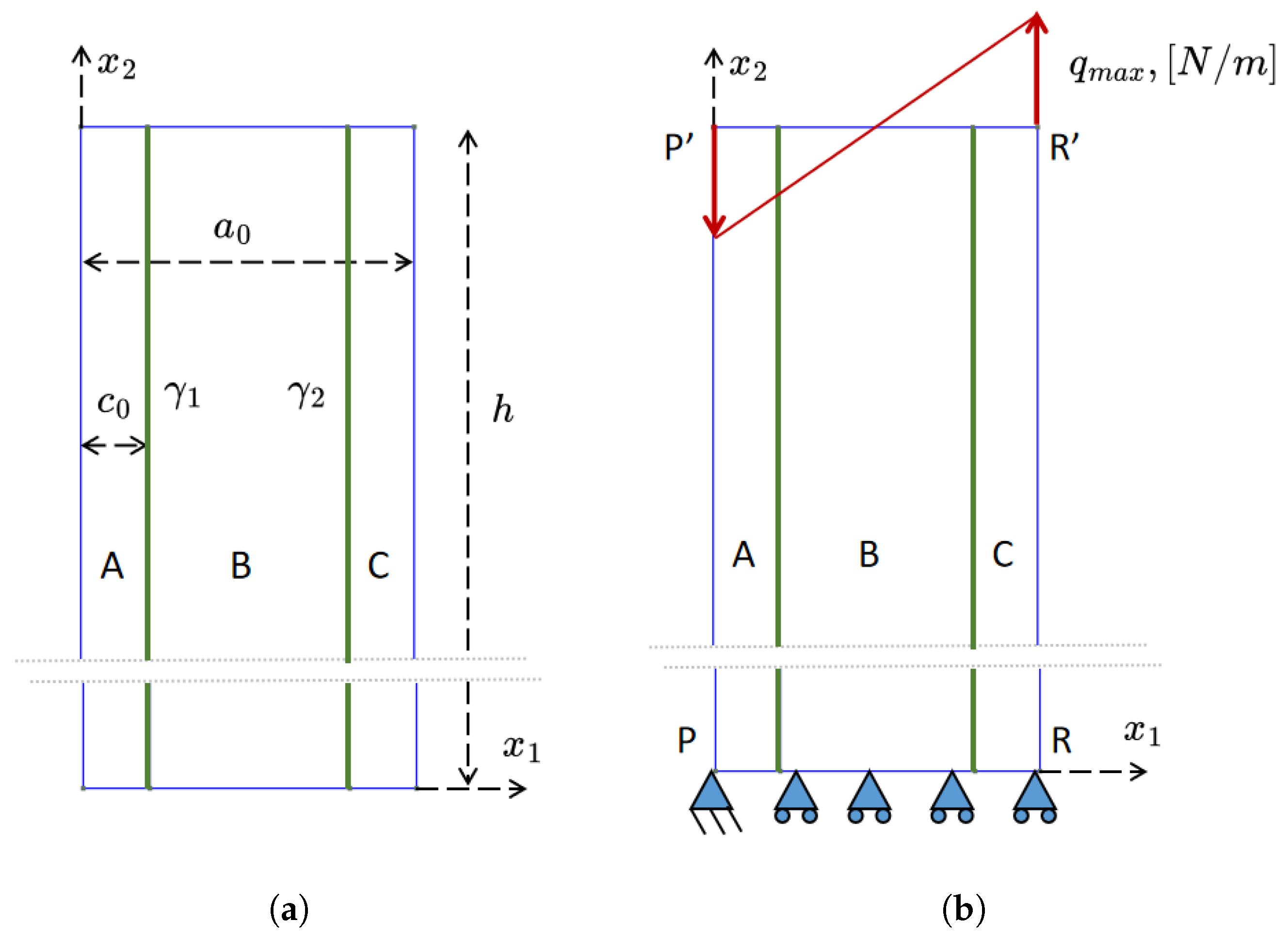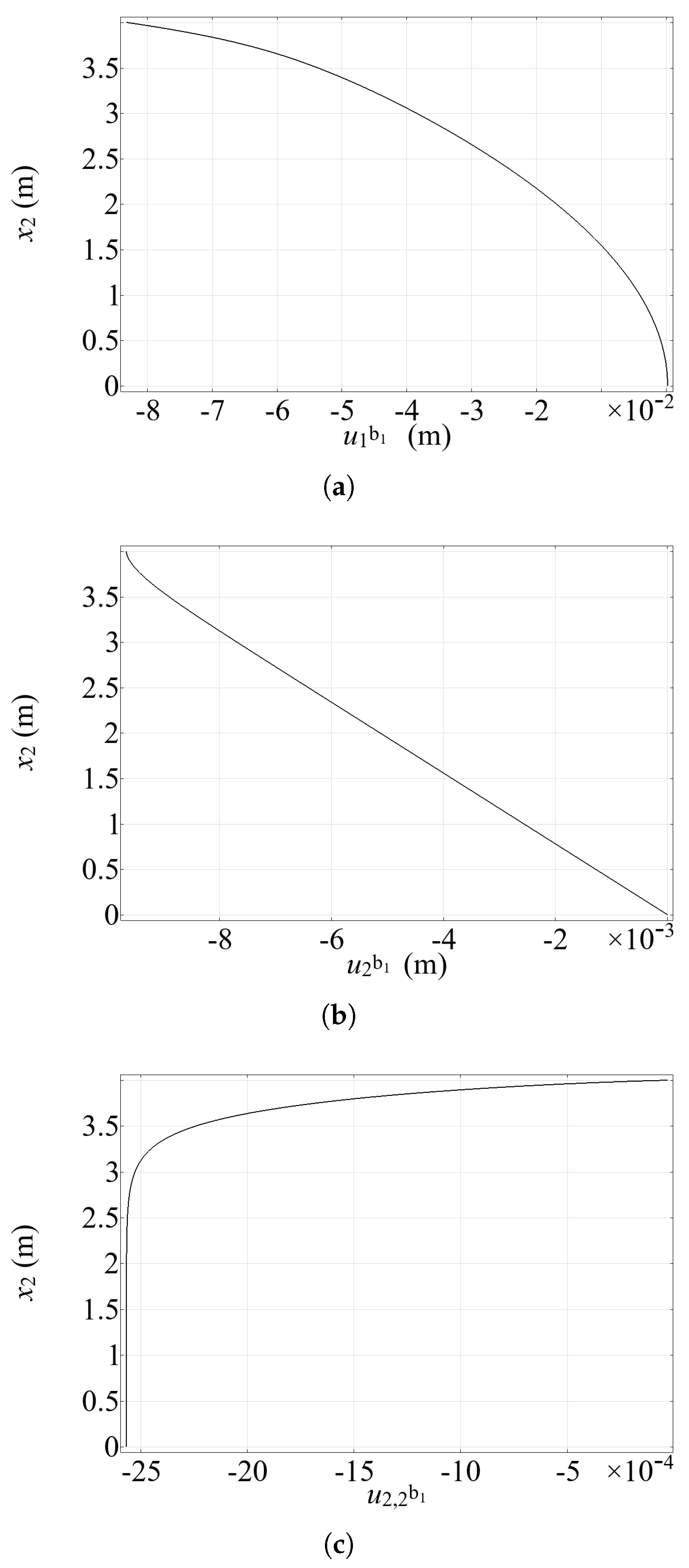Embedding 1D Euler Beam in 2D Classical Continua
Abstract
1. Introduction
Notation
2. Materials and Methods
2.1. Reinforced 2D Continua
2.1.1. Kinematic Descriptors and Restrictions
2.1.2. Potential Energy of the Applied External Force
2.1.3. Elastic Energy Density of 2D Domains
2.1.4. Elastic Energy Density for 1D Euler–Bernoulli Beams
2.2. Variational Deduction of Governing Equations and Boundary Conditions
2.3. Finite Element Implementation and Preliminary Numerical Results
3. Discussion
4. Closing Remarks and Future Prospects
Author Contributions
Funding
Data Availability Statement
Conflicts of Interest
References
- Hansbo, P.; Larson, M.G. Nitsche’s finite element method for model coupling in elasticity. Comput. Methods Appl. Mech. Eng. 2022, 392, 114707. [Google Scholar] [CrossRef]
- Steinbrecher, I.; Mayr, M.; Grill, M.J.; Kremheller, J.; Meier, C.; Popp, A. A mortar-type finite element approach for embedding 1D beams into 3D solid volumes. Comput. Mech. 2020, 66, 1377–1398. [Google Scholar] [CrossRef]
- Steinbrecher, I.; Popp, A.; Meier, C. Consistent coupling of positions and rotations for embedding 1D Cosserat beams into 3D solid volumes. Comput. Mech. 2021, 69, 701–732. [Google Scholar] [CrossRef]
- Yamamoto, T.; Yamada, T.; Matsui, K. Numerical procedure to couple shell to solid elements by using Nitsche’s method. Comput. Mech. 2019, 63, 69–98. [Google Scholar] [CrossRef]
- Shim, K.W.; Monaghan, D.J.; Armstrong, C.G. Mixed Dimensional Coupling in Finite Element Stress Analysis. Eng. Comput. 2002, 18, 241–252. [Google Scholar] [CrossRef]
- Klarmann, S.; Wackerfuß, J.; Klinkel, S. Coupling 2D continuum and beam elements: A mixed formulation for avoiding spurious stresses. Comput. Mech. 2022, 70, 1145–1166. [Google Scholar] [CrossRef]
- McCune, R.W.; Armstrong, C.G.; Robinson, D.J. Mixed-dimensional coupling in finite element models. Int. J. Numer. Methods Eng. 2000, 49, 725–750. [Google Scholar] [CrossRef]
- Monaghan, D.J.; Doherty, I.W.; McCourt, D.; Armstrong, C.G. Coupling 1D beams to 3D bodies. In Proceedings of the International Meshing Roundtable Conference, Dearborn, MI, USA, 26–28 October 1998. [Google Scholar]
- Niggl, A.; Düster, A.; Rank, E. Coupling 1D and 2D elasticity problems by using the hp-d-version of the finite element method. In Proceedings of the Second MIT Conference on Computational Fluid and Solid Mechanics, Cambridge, MA, USA, 17–20 June 2003. [Google Scholar]
- De Schepper, H. Finite Element Approximation of a 2D–1D Contact Eigenvalue Problem. Numer. Funct. Anal. Optim. 2005, 25, 349–362. [Google Scholar] [CrossRef]
- Barretta, R.; Feo, L.; Luciano, R.; Marotti de Sciarra, F. Variational formulations for functionally graded nonlocal Bernoulli–Euler nanobeams. Compos. Struct. 2015, 129, 80–89. [Google Scholar] [CrossRef]
- Lu, Y.; Henry, H.S. Numerical modelling of reinforced concrete walls with minimum vertical reinforcement. Eng. Struct. 2017, 143, 330–345. [Google Scholar] [CrossRef]
- Horla, D. Variational Calculus Approach to Optimal Interception Task of a Ballistic Missile in 1D and 2D Cases. Algorithms 2019, 12, 148. [Google Scholar] [CrossRef]
- Ferreira, D.; Bairán, J.; Antonio Marí, A. Numerical simulation of shear-strengthened RC beams. Eng. Struct. 2013, 46, 359–374. [Google Scholar] [CrossRef]
- Pros, A.; Diez, P.; Molins, C. Modeling steel fiber reinforced concrete: Numerical immersed boundary approach and a phenomenological mesomodel for concrete-fiber interaction. Int. J. Numer. Methods Eng. 2012, 90, 65–86. [Google Scholar] [CrossRef]
- Belliazzi, S.; Lignola, G.P.; Cosenza, E.; Fabbrocino, F. Non-linear analysis of rectangular cross-sections with different reinforcements: Dimensionless closed form solution. Mater. Struct. 2024, 57, 33. [Google Scholar] [CrossRef]
- Dell’Isola, F.; Eremeyev, V.A.; Korolenko, V.A.; Solyaev, Y.O. Deformation of an elastic second gradient spherical body under equatorial line density of dead forces. Eur. J. Mech.-A/Solids 2024, 103, 105153. [Google Scholar] [CrossRef]
- Nikabadze, M.U. Splitting of Initial Boundary Value Problems in Anisotropic Linear Elasticity Theory. Mosc. Univ. Mech. Bull. 2019, 74, 103–110. [Google Scholar] [CrossRef]
- Wang, F.F.; Dai, H.H.; Giorgio, I. A numerical comparison of the uniformly valid asymptotic plate equations with a 3D model: Clamped rectangular incompressible elastic plates. Math. Mech. Solids 2022, 27, 1370–1396. [Google Scholar] [CrossRef]
- Nikabadze, M. On Some Issues of Second Strain Tensor and Velocity Vector Gradient Theories of 3D Bodies and Thin Bodies. Lobachevskii J. Math. 2024, 45, 3683–3706. [Google Scholar] [CrossRef]
- Cuomo, M.; dell’Isola, F.; Greco, L. Simplified analysis of a generalized bias test for fabrics with two families of inextensible fibres. Z. Angew. Math. Phys. 2016, 67, 61. [Google Scholar] [CrossRef]
- Eremeyev, V.A.; Cazzani, A.; dell’Isola, F. On nonlinear dilatational strain gradient elasticity. Contin. Mech. Thermodyn. 2021, 33, 1429–1463. [Google Scholar] [CrossRef]
- Afshar, R.; Jeanne, S.; Abali, B.E. Nonlinear material modeling for mechanical characterization of 3D printed pla polymer with different infill densities. Appl. Compos. Mater. 2023, 30, 987–1001. [Google Scholar] [CrossRef]
- Barchiesi, E.; Dell’Isola, F.; Bersani, A.M.; Turco, E. Equilibria determination of elastic articulated duoskelion beams in 2D via a Riks-type algorithm. Int. J. Non-Linear Mech. 2021, 128, 103628. [Google Scholar] [CrossRef]
- Barchiesi, E. Multi-scale and multi-physics: Towards next-generation engineering materials. Contin. Mech. Thermodyn. 2020, 32, 541–554. [Google Scholar] [CrossRef]
- Stilz, M.; Dell’Isola, F.; Giorgio, I.; Eremeyev, V.A.; Ganzenmüller, G.; Hiermaier, S. Continuum models for pantographic blocks with second gradient energies which are incomplete. Mech. Res. Commun. 2022, 125, 103988. [Google Scholar] [CrossRef]
- Eremeyev, V.A.; Dell’Isola, F. On weak solutions of the boundary value problem within linear dilatational strain gradient elasticity for polyhedral Lipschitz domains. Math. Mech. Solids 2022, 27, 433–445. [Google Scholar] [CrossRef]
- Nikabadze, M.; Ulukhanyan, A. Some Variational Principles in the Three-Dimensional Micropolar Theories of Solids and Thin Solids. In Theoretical Analyses, Computations, and Experiments of Multiscale Materials. Advanced Structured Materials; Springer: Cham, Switzerland, 2022; Volume 175. [Google Scholar] [CrossRef]
- Barchiesi, E.; Harsch, J.; Ganzosch, G.; Eugster, S.R. Discrete versus homogenized continuum modeling in finite deformation bias extension test of bi-pantographic fabrics. Contin. Mech. Thermodyn. 2023, 35, 863–876. [Google Scholar] [CrossRef]
- Gazzo, S.; Contrafatto, L.; Greco, L.; Cuomo, M. Anisotropic behaviours and strain concentration in lattice material evaluated by means of discrete homogenization. Mater. Res. Proc. 2023, 26, 517–522. [Google Scholar]
- Yang, H.; Timofeev, D.; Giorgio, I.; Müller, W.H. Effective strain gradient continuum model of metamaterials and size effects analysis. Contin. Mech. Thermodyn. 2023, 35, 775–797. [Google Scholar] [CrossRef]
- Holler, S.; Butenweg, C.; Noh, S.-Y.; Meskouris, K. Computational model of textile-reinforced concrete structures. Comput. Struct. 2004, 82, 1971–1979. [Google Scholar] [CrossRef]
- Turco, E.; Barchiesi, E.; Giorgio, I.; Dell’Isola, F. A Lagrangian Hencky-type non-linear model suitable for metamaterials design of shearable and extensible slender deformable bodies alternative to Timoshenko theory. Int. J. Non-Linear Mech. 2020, 123, 103481. [Google Scholar] [CrossRef]
- Mukhopadhyay, S.; Khatana, S. A review on the use of fibers in reinforced cementitious concrete. J. Ind. Text. 2014, 45, 239–264. [Google Scholar] [CrossRef]
- Rajak, D.K.; Pagar, D.D.; Menezes, P.L.; Linul, E. Fiber-Reinforced Polymer Composites: Manufacturing, Properties, and Applications. Polymers 2019, 11, 1667. [Google Scholar] [CrossRef] [PubMed]
- Lim, D.H.; Oh, B.H. Experimental and theoretical investigation on the shear of steel fibre reinforced concrete beams. Eng. Struct. 1999, 21, 937–944. [Google Scholar] [CrossRef]
- Soldatos, K.P. Second-gradient plane deformations of ideal fibre-reinforced materials: Implications of hyper-elasticity theory. J. Eng. Math. 2010, 68, 99–127. [Google Scholar] [CrossRef]
- Kant, T.; Gupta, A. A finite element model for a higher-order shear-deformable beam theory. J. Sound Vib. 1988, 125, 193–202. [Google Scholar] [CrossRef]
- Fedele, R. Approach à la Piola for the equilibrium problem of bodies with second gradient energies. Part II: Variational derivation of second gradient equations and their transport. Contin. Mech. Thermodyn. 2022, 34, 1087–1111. [Google Scholar] [CrossRef]
- Dell’Isola, F.; Seppecher, P.; Placidi, L.; Barchiesi, E.; Misra, A. Least Action and Virtual Work Principles for the Formulation of Generalized Continuum Models. In Discrete and Continuum Models for Complex Metamaterials; Cambridge University Press: Cambridge, UK, 2020; pp. 327–394. [Google Scholar] [CrossRef]
- Ricceri, B. A general variational principle and some of its applications. J. Comput. Appl. Math. 2000, 113, 401–410. [Google Scholar] [CrossRef]
- dell’Isola, F.; Sciarra, G.; Vidoli, S. Generalized Hooke’s law for isotropic second gradient materials. Proc. R. Soc. A. 2009, 465, 2177–2196. [Google Scholar] [CrossRef]
- Seliger, R.L.; Beresford, W.G. Variational principles in continuum mechanics. Proc. R. Soc. Lond. 1968, 305, 1–25. [Google Scholar]
- COMSOL, Inc. COMSOL Multiphysics Reference Manual, Version 6.0. Available online: https://doc.comsol.com/6.0/doc/com.comsol.help.comsol/COMSOL_ReferenceManual.pdf (accessed on 30 December 2024).
- Kostin, G.; Saurin, V. Analytical derivation of basis functions for Argyris triangle. Z. Angew. Math. Mech. 2001, 81, 127–278. [Google Scholar]
- Mohr, G.A. A triangular finite element for thick slabs. Comput. Struct. 1978, 9, 595–598. [Google Scholar] [CrossRef]
- Ganguly, P.; Poole, W.J. Influence of reinforcement arrangement on the local reinforcement stresses in composite materials. J. Mech. Phys. Solids 2004, 52, 1355–1377. [Google Scholar] [CrossRef]
- Haque, N.; Gohl, J.; Chang, C.C.; Chang, H.C.; Davis, C.S. Quantifying Localized Stresses in the Matrix of a Fiber-Reinforced Composite via Mechanophores. Macromol. Chem. Phys. 2023, 224, 2300298. [Google Scholar] [CrossRef]
- Allena, R.; Scerrato, D.; Bersani, A.M.; Giorgio, I. A model for the bio-mechanical stimulus in bone remodelling as a diffusive signalling agent for bones reconstructed with bio-resorbable grafts. Mech. Res. Commun. 2023, 129, 104094. [Google Scholar] [CrossRef]
- Tepedino, M.; D’Annibale, F.; Giorgio, I.; Bednarczyk, E.; George, D. Predictive models for bone remodeling during orthodontic tooth movement: A scoping review on the “biological metamaterial” periodontal ligament interface. Contin. Mech. Thermodyn. 2025, 37, 1–17. [Google Scholar] [CrossRef]
- Yildizdag, M.E.; Barchiesi, E.; Dell’Isola, F. Three-point bending test of pantographic blocks: Numerical and experimental investigation. Math. Mech. Solids 2020, 25, 1965–1978. [Google Scholar] [CrossRef]
- Giorgio, I.; Dell’Isola, F.; Steigmann, D.J. Second-grade elasticity of three-dimensional pantographic lattices: Theory and numerical experiments. Contin. Mech. Thermodyn. 2024, 36, 1181–1193. [Google Scholar] [CrossRef]






| Mesh Type | Elements Along Interfaces | Degrees of Freedom | Nodes (Total/Interface) |
|---|---|---|---|
| Coarse Mesh | 562 | 6206 | 337/68 |
| Medium Mesh | 1922 | 27,250 | 1412/112 |
| Fine Mesh | 8002 | 205,004 | 10,641/840 |
Disclaimer/Publisher’s Note: The statements, opinions and data contained in all publications are solely those of the individual author(s) and contributor(s) and not of MDPI and/or the editor(s). MDPI and/or the editor(s) disclaim responsibility for any injury to people or property resulting from any ideas, methods, instructions or products referred to in the content. |
© 2025 by the authors. Licensee MDPI, Basel, Switzerland. This article is an open access article distributed under the terms and conditions of the Creative Commons Attribution (CC BY) license (https://creativecommons.org/licenses/by/4.0/).
Share and Cite
Ulukhanyan, A.; Placidi, L.; Misra, A.; Fedele, R.; Luciano, R.; Fabbrocino, F. Embedding 1D Euler Beam in 2D Classical Continua. Fibers 2025, 13, 88. https://doi.org/10.3390/fib13070088
Ulukhanyan A, Placidi L, Misra A, Fedele R, Luciano R, Fabbrocino F. Embedding 1D Euler Beam in 2D Classical Continua. Fibers. 2025; 13(7):88. https://doi.org/10.3390/fib13070088
Chicago/Turabian StyleUlukhanyan, Armine, Luca Placidi, Anil Misra, Roberto Fedele, Raimondo Luciano, and Francesco Fabbrocino. 2025. "Embedding 1D Euler Beam in 2D Classical Continua" Fibers 13, no. 7: 88. https://doi.org/10.3390/fib13070088
APA StyleUlukhanyan, A., Placidi, L., Misra, A., Fedele, R., Luciano, R., & Fabbrocino, F. (2025). Embedding 1D Euler Beam in 2D Classical Continua. Fibers, 13(7), 88. https://doi.org/10.3390/fib13070088








